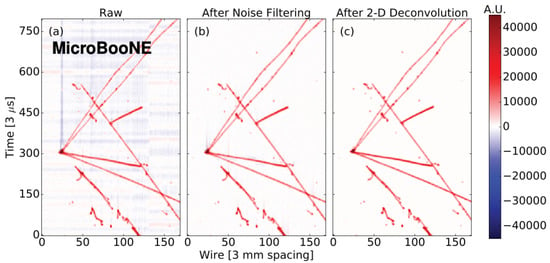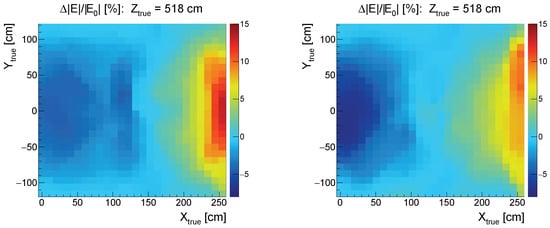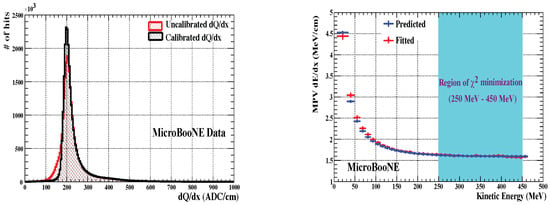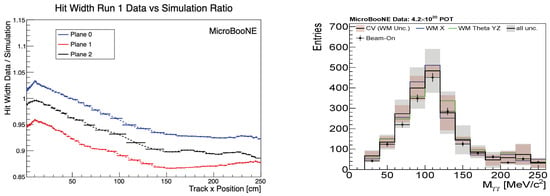Abstract
The Liquid Argon Time Projection Chamber (LArTPC) is increasingly becoming the chosen technology for current and future precision neutrino oscillation experiments due to its superior capability in particle tracking and energy calorimetry. In LArTPCs, calorimetric information is critical for particle identification, which is the foundation for neutrino cross-sections and oscillation measurements, as well as searches for beyond-standard-model physics. One of the primary challenges in employing LArTPC technology is characterizing its performance and quantifying the associated systematic uncertainties. MicroBooNE, the longest-operating LArTPC to date, has performed numerous such measurements, including studies of detector physics and electromagnetic shower reconstruction. Here, we present results on the operation and performance of the detector during its data taking, highlighting accomplishments toward calorimetric reconstruction, calibration, and detector physics.
1. Introduction
MicroBooNE is a part of the Short-Baseline Neutrino (SBN) program at Fermilab []. The detector is an 85-ton active volume liquid argon time projection chamber (LArTPC) located on-axis in the Booster Neutrino Beam (BNB) line. It sits ∼470 m away from the target station and expects an on-axis flux of neutrinos with energies of approximately 0.2 GeV to 2 GeV []. It is also exposed to an off-axis flux of neutrinos from the NuMI neutrino beam []. MicroBooNE began collecting data in 2015 and ended its physics run in 2021. It acquired the largest statistics samples of neutrino interactions on argon to date.
The MicroBooNE LArTPC has an active volume of (drift coordinate (x), vertical (y), beam direction (z)). Charged particles traversing the TPC can ionize the argon, leaving trails of ionization electrons, and produce scintillation light. The ionization electrons drift in an applied electric field (273 V/cm) to the three anode wire planes that provide the charge readout. The wire angles are from vertical for the two induction planes, U and V, and vertical for the collection plane, Y (Y plane is the farthest from the cathode). The U, V, and Y planes (Plane 0, Plane 1, and Plane 2) contain 2400, 2400, and 3456 wires, respectively. The plane spacing and wire pitch are both 3 mm. The U and V plane wires detect signals via induction, while the Y plane wires collect the charge, which generally has the best resolution when converting the charge to energy [].
2. Signal Processing
The charge information collected is recorded in the waveform from each wire channel. In the MicroBooNE LArTPC, common noise contains the coherent noise, tails, etc., mainly inherent to electronics. The noise characteristics were studied in the frequency and time domains, and offline noise filters were developed to mitigate the noise []. The measured signal is a convolution of the original signal and detector response. For signal processing, a deconvolution method is used to extract the original signal from the measured signal to remove the detector response [,]. Figure 1 shows the event displays of an example neutrino candidate from MicroBooNE data at different stages: raw data, after noise filtering, and after deconvolution []. The output of this deconvolution is a standard signal shape, i.e., a Gaussian shape, for the hit (charge) reconstruction.

Figure 1.
Event displays of an example neutrino candidate from MicroBooNE data (run 3493, event 41,075) showing a Y-plane view through each stage of signal processing. Figure is taken from Ref. [].
3. LArTPC Calibration and Energy Reconstruction
LArTPC technology can provide excellent spatial and calorimetric resolutions. However, the total charge extracted after signal processing normally does not equal the total charge produced from ionization. Distortions in the detector response due to cross-connected TPC channels, space charge effects (SCE), electron attachment to impurities, diffusion, and recombination need to be corrected to obtain the exact amount of charge released from the original interaction []. MicroBooNE is a near-surface detector. There are about 20–30 cosmic muons per 4.8 ms readout window. The accumulation of slow-moving argon ions produced from cosmic muons impinging the TPC can distort the electrical field and the drift trajectories of ionization electrons. Such effects are known as SCE [,,]. Calibration of the electric field can be achieved by using the cosmic muon tracks [] or the UV laser system []. Figure 2 shows an example electric field distortion magnitude for simulation and data using selected cosmic muon tracks []. The SCE has larger effects near the cathode (∼256 cm).

Figure 2.
Results of the calculation of electric field distortion magnitude for a central slice in z, comparing Monte Carlo simulation (left) to data (right). The distortion is due to SCE. Figure is taken from Ref. [].
To obtain precise measurements of particle tracking and energy reconstruction, the following two-step calibration was performed. First, we corrected the position and time dependence of the detector response to the ionization charge using data from anode–cathode crossing cosmic muons, which span the entire drift distance and can be used to study any effects that depend on drift distance. This process is known as calibration. Second, stopping muons from neutrino interactions or cosmic rays were used to study the measured and predicted most probable (energy loss per unit length) value. We then determined the calibration constant C in a unit of ADC/e (used to convert ADC values to number of electrons (“e”)), which translates the corrected in a unit of ADC/cm to in a unit of e/cm. This process is know as calibration []. Figure 3 shows examples of calibrated and uncalibrated from the crossing muons and the comparison between the prediction and the fitted most probable value for stopping muons in MicroBooNE data using the collection plane. The calibration of two induction planes can be accomplished independently following the same strategy.

Figure 3.
Calibrated and uncalibrated from crossing muons in MicroBooNE data in the collection plane (left), and comparison between the predicted and fitted most probable values for stopping muons in MicroBooNE data using the collection plane (right). Plots are taken from Ref. [].
Stopping protons were used to further refine the relationship between the measured charge and the energy loss for highly ionizing particles. The effective recombination was studied by comparing the measured and the distribution to different recombination models [].
4. Detector-Related Uncertainties
To understand the detector effects and quantify the associated systematic uncertainties, modifications to the simulation waveforms based on a parameterization of observed differences in the ionization signals from the TPC between data and simulation were considered, in addition to other TPC variations such as electric field nonuniformities and recombination. Figure 4 shows an example of a comparison of hit width (a hit has an integrated charge Q, proportional to the number of ionization electrons that produced the wire signal, and a width , measured in waveform time ticks) as a function of x between data and simulation, and the measured diphoton invariant mass distribution using BNB beam data with uncertainties. The novel approach for evaluating detector-related uncertainties in a LArTPC could be applied to future LArTPC detectors, such as those used in the SBN and DUNE [].

Figure 4.
Ratio (data/simulation) and fitted simulation modification functions for mean hit width vs. x on each of the three wire planes (left), and measured diphoton invariant mass distribution using BNB beam data with uncertainties (right). Plots are taken from Ref. [].
5. Summary
MicroBooNE, the first operating detector in the Fermilab SBN program, has collected the world’s largest dataset of neutrino–argon interactions. The energy reconstruction and detector calibration strategies developed in MicroBooNE LArTPC can provide precision information for particle identification and measurements and are used in MicroBooNE’s physics analyses such as the recent LEE results []. They help advance our understanding of LArTPC detector technology and have been applied to other detectors used in the SBN and DUNE.
Funding
This document was prepared by the MicroBooNE Collaboration using the resources of the Fermi National Accelerator Laboratory (Fermilab), a U.S. Department of Energy, Office of Science, HEP User Facility. Fermilab is managed by Fermi Research Alliance, LLC (FRA), acting under Contract No. DE- AC02-07CH11359. MicroBooNE is supported by the following: the U.S. Department of Energy, Office of Science, Offices of High Energy Physics and Nuclear Physics; the U.S. National Science Foundation; the Swiss National Science Foundation; the Science and Technology Facilities Council (STFC), part of the United Kingdom Research and Innovation; the Royal Society (United Kingdom); and The European Unions Horizon 2020 Marie Sklodowska-Curie Actions. Additional support for the laser calibration system and cosmic-ray tagger was provided by the Albert Einstein Center for Fundamental Physics, Bern, Switzerland.
Data Availability Statement
Not applicable.
Acknowledgments
We also acknowledge the contributions of technical and scientific staff to the design, construction, and operation of the MicroBooNE detector as well as the contributions of past collaborators to the development of MicroBooNE analyses, without whom this work would not have been possible.
Conflicts of Interest
The author declares no conflict of interest.
References
- Acciarri, R.; Adams, C.; An, R.; Andreopoulos, C.; Ankowski, A.M.; Antonello, M.; Asaadi, J.; Badgett, W.; Bagby, L.; Baibussinov, B.; et al. [MicroBooNE, LAr1-ND and ICARUS-WA104 Collaborations]. A Proposal for a Three Detector Short-Baseline Neutrino Oscillation Program in the Fermilab Booster Neutrino Beam. arXiv 2015, arXiv:1503.01520. [Google Scholar]
- Aguilar-Arevalo, A.A.; Anderson, C.E.; Bazarko, A.O.; Brice, S.J.; Brown, B.C.; Bugel, L.; Cao, J.; Coney, L.; Conrad, J.M.; Cox, D.C.; et al. [MiniBooNE Collaboration]. The Neutrino Flux prediction at MiniBooNE. Phys. Rev. D 2018, 79, 072002. [Google Scholar] [CrossRef]
- Adamson, P.; Anderson, K.; Andrews, M.; Andrews, R.; Anghel, I.; Augustine, D.; Aurisano, A.; Avvakumov, S.; Ayres, D.S.; Baller, B.; et al. [The NuMI Neutrino Beam]. Nucl. Instrum. Meth. A 2016, 806, 279. [Google Scholar] [CrossRef]
- Acciarri, R.; Adams, C.; An, R.; Aparicio, A.; Aponte, S.; Asaadi, J.; Auger, M.; Ayoub, N.; Bagby, L.; Baller, B.; et al. [MicroBooNE Collaboration]. Design and construction of the MicroBooNE detector. J. Instrum. 2017, 12, P02017. [Google Scholar] [CrossRef]
- Acciarri, R.; Adams, C.; An, R.; Anthony, J.; Asaadi, J.; Auger, M.; Bagby, L.; Balasubramanian, S.; Baller, B.; Barnes, C.; et al. [MicroBooNE Collaboration]. Noise Characterization and Filtering in the MicroBooNE Liquid Argon TPC. J. Instrum. 2017, 12, P08003. [Google Scholar] [CrossRef]
- Adams, C.; An, R.; Anthony, J.; Asaadi, J.; Auger, M.; Bagby, L.; Balasubramanian, S.; Baller, B.; Barnes, C.; Barr, G.; et al. [MicroBooNE Collaboration]. Ionization electron signal processing in single phase LArTPCs. Part I. Algorithm Description and quantitative evaluation with MicroBooNE simulation. J. Instrum. 2018, 13, P07006. [Google Scholar] [CrossRef]
- Adams, C.; An, R.; Anthony, J.; Asaadi, J.; Auger, M.; Balasubramanian, S.; Baller, B.; Barnes, C.; Barr, G.; Basset, M.; et al. [MicroBooNE Collaboration]. Ionization electron signal processing in single phase LArTPCs. Part II. Data/simulation comparison and performance in MicroBooNE. J. Instrum. 2018, 13, P07007. [Google Scholar] [CrossRef]
- Adams, C.; Alrashed, M.; An, R.; Anthony, J.; Asaadi, J.; Ashkenazi, A.; Auger, M.; Balasubramanian, S.; Baller, B.; Barnes, C.; et al. [MicroBooNE Collaboration]. Calibration of the charge and energy loss per unit length of the MicroBooNE liquid argon time projection chamber using muons and protons. J. Instrum. 2020, 15, P03022. [Google Scholar] [CrossRef]
- Abratenko, P.; Alrashed, M.; An, R.; Anthony, J.; Asaadi, J.; Ashkenazi, A.; Balasubramanian, S.; Baller, B.; Barnes, C.; Barr, G.; et al. [MicroBooNE Collaboration]. Measurement of space charge effects in the MicroBooNE LArTPC using cosmic muons. J. Instrum. 2020, 15, P12037. [Google Scholar] [CrossRef]
- Adams, C.; Alrashed, M.; An, R.; Anthony, J.; Asaadi, J.; Ashkenazi, A.; Balasubramanian, S.; Baller, B.; Barnes, C.; Barr, G.; et al. [MicroBooNE Collaboration]. A method to determine the electric field of liquid argon time projection chambers using a UV laser system and its application in MicroBooNE. J. Instrum. 2020, 15, P07010. [Google Scholar] [CrossRef]
- Abratenko, P.; An, R.; Anthony, J.; Arellano, L.; Asaadi, J.; Ashkenazi, A.; Balasubramanian, S.; Baller, B.; Barnes, C.; Barr, G.; et al. [MicroBooNE Collaboration]. Novel approach for evaluating detector-related uncertainties in a LArTPC using MicroBooNE data. Eur. Phys. J. C 2022, 82, 454. [Google Scholar] [CrossRef]
- Abratenko, P.; An, R.; Anthony, J.; Arellano, L.; Asaadi, J.; Ashkenazi, A.; Balasubramanian, S.; Baller, B.; Barnes, C.; Barr, G.; et al. [MicroBooNE Collaboration] Search for an Excess of Electron Neutrino Interactions in MicroBooNE Using Multiple Final-State Topologies. Phys. Rev. Lett. 2022, 1128, 241801. [Google Scholar] [CrossRef] [PubMed]
Disclaimer/Publisher’s Note: The statements, opinions and data contained in all publications are solely those of the individual author(s) and contributor(s) and not of MDPI and/or the editor(s). MDPI and/or the editor(s) disclaim responsibility for any injury to people or property resulting from any ideas, methods, instructions or products referred to in the content. |
© 2023 by the author. Licensee MDPI, Basel, Switzerland. This article is an open access article distributed under the terms and conditions of the Creative Commons Attribution (CC BY) license (https://creativecommons.org/licenses/by/4.0/).